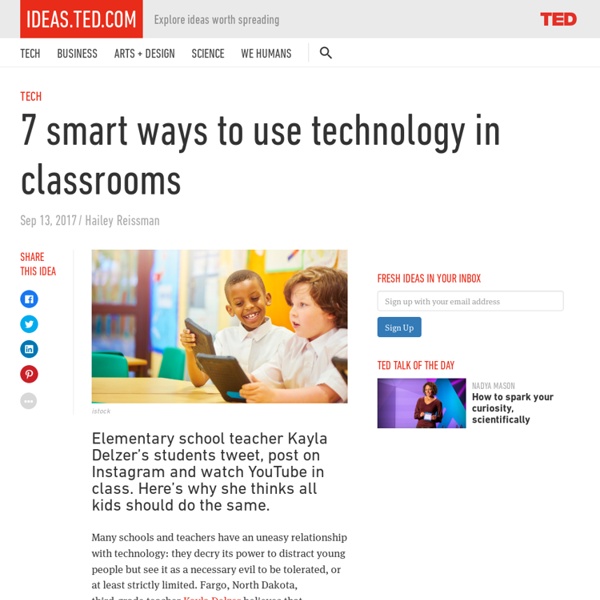8 Engaging Ways to use Technology in the Classroom to Create Lessons That Aren’t Boring
Are you tired of delivering the same old lectures on the same subjects year after year? Are you using the same lesson materials over and over and wishing you could make learning in your classroom more interactive? While lectures and lessons can be informative and even “edutaining” when delivered with passion and good materials by knowledgeable experts, sadly many traditional lectures and lessons are boring, and even worse often ineffective. The good news is that the Web is loaded with great free tools that can enable teachers to bring a sense of fun and engagement to their lessons. Of course, you do need devices with Internet access to give these tools a try. Even if you don’t have computers or tablets available in your classroom, the fact that an increasing number of High School and college students have smartphones is making it easier than ever to leverage technology to create engaging, active lessons students enjoy working on.
Technology and learning in the classroom: six tips to get the balance right
Australia was one of the first countries in the world to have more computers than students in schools. But as the numbers of computers and other technological devices increased, student performance did not. The days of cramming computers into classrooms and expecting improvements in learning are numbered. Some argue there’s little evidence to justify investment in technology in the classroom. In fact, some studies even suggest potential harms. Some have suggested links between screen time and increased ADHD, screen addiction, aggression, depression, and anxiety, dizziness, headaches and blurred vision.
25 Easy Ways to Use Technology in the Classroom
Although many technology-based teaching methods and resources effectively engage students and build their skills, many educators encounter difficulties when using technology in the classroom. Maybe a specific platform is too hard to introduce. Or maybe it won’t run on your devices. Despite the challenges, you likely want to enjoy the benefits that education technology can deliver. Using the ones that best apply to you and your students, and keeping the condensed list on your desk for quick reference, consider these 25 easy ways to use technology in the classroom:
Pros & Cons of Using Technology in the Elementary Classroom
Elementary Technology In a world driven by smartphones and other mobile devices, it's really no surprise that technology has found a home in the elementary classroom. In fact, according to a 2009 infographic published by the National Center for Education Statistics (NCES), 98% of elementary school teachers had computers in the classroom every day. Another 2012 infographic published by Everyday Family shows that 57% of kids under 12 have used a mobile device for educational purposes.
75 Digital Tools and Apps Teachers Can Use to Support Formative Assessment in the Classroom
There is no shortage of formative assessment strategies, techniques, and tools available to teachers who use formative instructional practice in their classrooms. Here is an extensive list of 75 digital tools, apps, and platforms that can help you and your students use formative assessment to elicit evidence of learning. We didn’t just add any old tool to this list. Here are the criteria we used for those that made the cut: Supports formative instructional strategies and ways to activate learners to be resources for themselves and peersIs free or awful close to it (under $10 per year, where possible)When possible, both students and teachers can take the activator role (sometimes teachers need to get things started)
27 Tech Tools Teachers Can Use to Inspire Classroom Creativity
Students who grow up with a love of learning are more likely to stay engaged in STEAM subjects and other lessons as they grow older. They won’t take what they learn at face value, and will instead seek out ways to expand their knowledge and ask questions about what they learn. Teachers are always looking for ways to pique student interest, from engaging experiments to unique learning methods.
How to use technology in the classroom - CAE Computer Aided E-learning
Technology in the classroom now plays a very big role in the effectiveness of education. Whether your students are five or fifty, it has become expected for teachers and tutors to utilise technology in order to better communicate course material. Many educational organisations offer courses that no longer need to take place in a traditional classroom. This includes language schools, universities and training course providers, many of which now offer a wide range of multimedia courses online. However, the choice here is not a matter of deciding on the traditional method or the digital one.
Four Brilliant Ways Teachers Use Technology in the Classroom
Resource Articles // Becoming an elementary school teacher has so many rewards, but with them comes the huge responsibility of inspiring and preparing children for the world that lies ahead. Students need certified teachers—those with a teaching degree–who are committed to engaging them in all areas relevant to today’s world.
25 Top Technology Apps for Teachers
Kylie HallTeacher.org Co-Founder Technology in the classroom is so commonplace at this point that writing a list about technology in the classroom actually seems cliché. In fact, just starting a piece about technology in the classroom by talking about technology in the classroom is probably cliché. Of course this doesn't mean we shouldn't be talking about it either.



